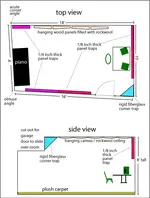C
cprescott1972
New member
I have built a small garage studio that's about 11' x 16' x 8' tall. The floor is padded carpet and the ceiling is canvas over rock wool. The walls are a mixture of wood bass trap panels and patches of drywall. There are 2 insulated, soft bass traps in the corners.
From the recordings that I am doing I have found build ups around 62 hz, 125, 250 etc. Then the highs are sort of lacking. The result is a sound that has a blanket over it. I can add highs but, I shouldn't have to brighten everything so much. Even things that are close miced sound dull....
I suppose the question really is what I should do to the ceilings since I don't want to invest too much more time or money. Perhaps I should put a reflective surface over some of the padded ceiling? IF this is a good route, would peg board, thin plywood or corrugated metal be possibilities? Any thoughts. Thanks!!!
From the recordings that I am doing I have found build ups around 62 hz, 125, 250 etc. Then the highs are sort of lacking. The result is a sound that has a blanket over it. I can add highs but, I shouldn't have to brighten everything so much. Even things that are close miced sound dull....
I suppose the question really is what I should do to the ceilings since I don't want to invest too much more time or money. Perhaps I should put a reflective surface over some of the padded ceiling? IF this is a good route, would peg board, thin plywood or corrugated metal be possibilities? Any thoughts. Thanks!!!


